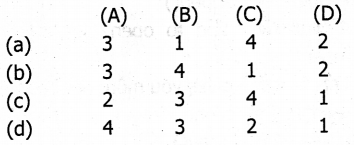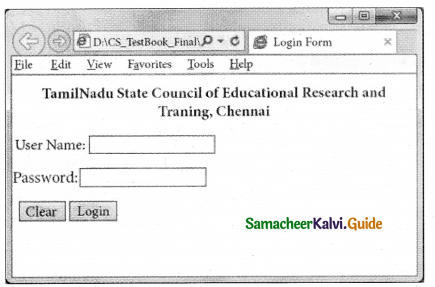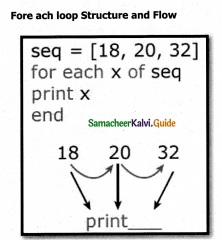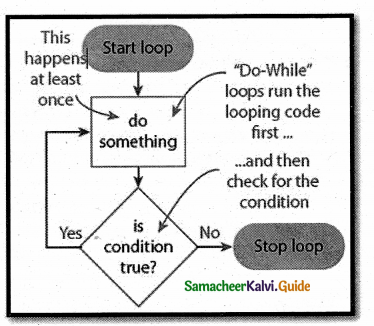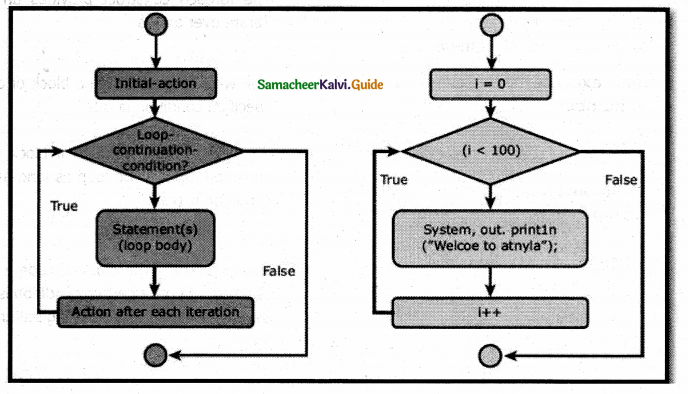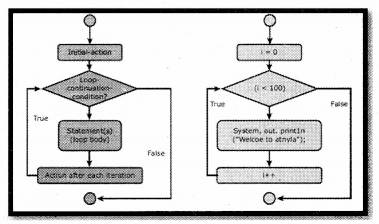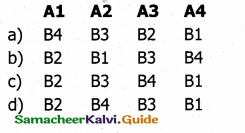Tamilnadu State Board New Syllabus Samacheer Kalvi 12th Computer Applications Guide Pdf Chapter 11 Network Examples and Protocols Text Book Back Questions and Answers, Notes.
Tamilnadu Samacheer Kalvi 12th Computer Applications Solutions Chapter 11 Network Examples and Protocols
12th Computer Applications Guide Network Examples and Protocols Text Book Questions and Answers
Part I
Choose The Correct Answers
Question 1.
The ……………., “the Net,” is a worldwide system of computer networks.
a) Internet
b) mobile
c) communication
d) protocol
Answer:
a) Internet
![]()
Question 2.
Which one of the following will be easy the way to uses Internet technology and the public telecommunication system to securely share business’s information with suppliers, vendors,partners and customers,
a) Extranet
b) Intranet
c) arpanet
d) arcnet
Answer:
a) Extranet
Question 3.
Natch the following and choose the correct answer
i. HTTP -The core protocol of the World Wide Web.
ii. FTP – enables a client to send and receive complete files from a server.
iii. SMTP – Provide e-mail services.
iv. DNS- Refer to other host computers by using names rather than numbers.
a) i, ii, iii, iv
b) ii, iii, iv, I
c) iii, iv, i, ii
d) iv, iii, ii, i
Answer:
a) i, ii, iii, iv
![]()
Question 4.
Communication over…………….. is be made up of voice, data,images and text messages.
a) Social media
b) mobile network
c) whatsapp
d) software
Answer:
b) mobile network
Question 5.
Wi-Fi stands for………………
a) Wireless Fidelity
b) wired fidelity
c) wired optic fibre
d) wireless optic fibre
Answer:
a) Wireless Fidelity
Question 6.
A TCP/IP network with access restricted to members of an organization
a) LAN
b) MAN
c) WAN
d) Intranet
Answer:
d) Intranet
![]()
Question 7.
RFID stands for …………………
a) Radio Free identification
b) real Frequency identity
c) Radio Frequency indicators
d) Radio Frequency Identification.
Answer:
d) Radio Frequency Identification.
Question 8.
If guarantees the sending of data is successful and which checks error on operation at OSI layer is……….
a) Application layer
b) Network layer
c) Transport Layer
d) Physical layer
Answer:
c) Transport Layer
Question 9.
Which one of the following will secure data on transmissions?
a) HTTPS
b) HTTP
c) FTP
d) SMTP
Answer:
a) HTTPS
Question 10.
………………. provides e-mail service
a) DNS
b) TCP
c) FTP
d) SMTP
Answer:
d) SMTP
Question 11.
……………. refer to other host computers by using names rather than numbers.
a) DNS
b) TCP
c) FTP
d) SMTP
Answer:
a) DNS
![]()
Question 12.
TCP/IP is a combination of two protocols:
i. Transmission Control Protocol (TCP)
ii. Internet Protocol (IP)
iii. Selection Protocol (SP)
iv. Captial Protocol (CP)
a) i, ii
b) i, iii
c) iii, iv
d) ii, iii
Answer:
a) i, ii
Part II
Short Answers
Question 1.
Define Intranet
Answer:
- It is a private network within an enterprise to share company data and computing resources between the employees.
- It may consist of many interlinked local area networks.
Question 2.
What are the uses of mobile networks?
Answer:
- Can connect the network without cable
- Less consumption of power
- Huge capacity than a large transmitter
- Covering large area than a single transmitter
![]()
Question 3.
List out the benefits of WiFi
Answer:
- It provides mobility.
- It provides connection to Internet.
- Flexibility of LAN.
- Ensures connectivity.
- It allows places that are remote to benefit from connectivity.
- Low cost, high benefit.
Question 4.
How many types of RFID system available and what are they?
Answer:
Two types of RFID were
- Active RFID and
- Passive RFID systems.
1. Active RFID system: The tag has its own power source.
2. Passive RFID system: The tag gets power through power from a reader antenna to the tag antenna.
Question 5.
Expand HTTP, HTTPS, FTP
Answer:
- HTTP – Hypertext Transfer Protocol
- HTTPS – Hypertext Transfer Protocol Secure
- FTP – File Transfer Protocol
Part III
Explain in brief answer
Question 1.
Compare Internet, Intranet, and Extranet
Answer:
| Type | Definition | Example |
| Internet | A global network, public TCP/IP network used by over a billion people all over the world | Sending an email to a friend |
| Intranet | A TCP/IP network with access restricted to members of an organization | Accessing your record in the employee personnel file |
| Extranet | TCP/IP network with restricted access to Members | Checking availability of inventory from an outside supplier |
Question 2.
List out the components of an RFID enabled system.
Answer:
- An RFID tag: It has a silicon microchip attached to a small antenna and mounted on a substrate,
- A Reader: It has a scanner with antennas to trans¬mit and receives signals, used for communication.
- A Controller: It is the host computer with a Microprocessor which receives the reader input and process the data.
![]()
Question 3.
Write short notes on HTTP, HTTPS, FTP.
Answer:
- HTTP – A protocol used between a web client and a webserver to protect non-secure data transmissions. The core protocol of the World Wide Web.
- HTTPS – A protocol used between a web client and a web server permits secure data transmissions.
- FTP – Used between computers for sending and receiving data. Enables a client to send and receive complete files from a server.
Question 4.
What are the layers available in TCP/IP Reference Model?
Answer:
- Application Layer
- Transport Layer
- Internet Layer
- Network Access Layer
![]()
Question 5.
Expand ARP, ICMP, SMTP, and DNS.
Answer:
- Address Resolution Protocol (ARP)
- Internet Control Message Protocol (ICMP)
- Transfer mission Control Protocol (TCP)
- Simple Mail Transfer Protocol (SMTP)
- Domain Name System (DNS).
Part IV
Explain in detail
Question 1.
Explain about Internet, Intranet and Ex¬tranet.
Answer:
INTERNET:
- The Internet, “the Net,” is a worldwide system of computer networks
- It is the network of networks where the users at any one computer can if they have permission, get information from any other computer.
- The Internet is a network of global connections.
- It comprises private, public, business, academic, and government networks
- It linked by guided, wireless, and fiber-optic technologies.
- The Internet denotes the global communication system, including infrastructure and hard¬ware whereas the web is one of the services interconnected over the Internet.
INTRANET:
- It is a private network within an enterprise to share company data and computing resources between the employees.
- It may consist of many interlinked local area networks.
- It includes connections through one or more gateway (connects two networks using different protocols together known as protocol convertor) computers to the outside Internet.
EXTRANET:
It is a private network that uses Internet technology and the public telecommunication system to securely share business information with suppliers, vendors, partners, customers, or other businesses.
Question 2.
Discuss OSI model with its layers.
Answer:
OSI Model
- Open System Interconnection (OSI) model was found in the year 1934, a general framework that enables network protocols along with software and systems to be developed based on a general set of guidelines.
- It describes the standards for the inter-computer communication.
OSI Layers:
1. Physical Layer:
- It is the 1st layer.
- It defines the electrical and physical specifications for devices.
2. Data Link Layer:
- It is the 2nd layer.
- It guarantees that the data transmitted are free of errors.
- This layer has simple protocols like “802.3 for Ethernet” and “802.11 for Wi-Fi”.
3. Network Layer:
- It is the 3rd layer.
- It is used to determine the path of the data packets.
- At this layer, routing of data packets is found using IP Addressing.
4. Transport Layer:
- It is the 4th layer.
- It guarantees the transportation/sending of data is successful.
- It includes the error checking operation.
5. Session Layer:
- It is the 5th layer
- It is used to identify the established system session between different network entities.
- It controls dialogues between computers.
- For instance, while accessing a system remotely, the session is created between your computer and the remote system.
6. Presentation Layer:
- It is the 6th layer.
- It does the translation of data to the next layer (Prepare the data to the Application Layer). Encryption and decryption protocols occur in this layer such as Secure Socket Layer (SSL).
7. Application Layer:
- It is the 7th layer.
- It acts as the user interface platform comprising software within the system.
![]()
Question 3.
Difference between TCP/IP and OSI Reference Model.
Answer:
Expands To TCP/IP- Transmission Control Protocol/OSI- Open system Interconnect
| Basic for comparison | TCP/IP model | OSI Model |
| Expands To | TCP/IP- Transmission Control Protocol/Internet Protocol | OSI- Open system Interconnect |
| Meaning | It is a client-server model used for the transmission of data over the internet. | It is a theoretical model which is used for a computing system. |
| No. Of Layers | 4 Layers | 7 Layers |
| Developed by | Department of Defense (DoD) | ISO (International Standard Organization) |
| Tangible | Yes | No |
| Usage | Mostly used | Never use |
Question 4.
Explain the development, merits, and demerits of Mobile networks.
Answer:
Merits of Mobile Networks:
- Higher efficiency.
- Increased ability to communicate in and out of the workspace.
- Greater access to modem apps and services.
- Improved networking capabilities.
- Quality and flexibility of services.
- Rapid developments in cloud technologies.
Demerits of Mobile Networks:
- Cost
- Vulnerable to security risks.
- Additional training is needed to use new technology.
- Cybercrime
Development:
The generations of mobile networks are as follows.
- First Generation (1G) 1981 – NMT Launch
- Second Generation (2G) 1991 – GSM Launch
- Second to Third Generation Bridge (2.5)2000 – GPRS launch
- Third Generation (3G) 2003 – first UK 3G launch
- Fourth Generation (4G) 2007
- Fifth Generation (5G) 2019+
1. First Generation (1G) 1981 – NMT launch:
- During the initial periods, the mobile systems were based on analog transmission.
- NMT stands for Nordic Mobile Telephone communication.
- And a very poor voice quality.
2. Second Generation(2G) 1991-GSM Launch:
- Later the second generation of mobile systems was placed on digital transmission with GSM.
- GSM stands for (Global System for Mobile communication) was the most popular standard which is used in the second generation, using 900MHz and 1800MHz for the frequency bands.
- The transfer mission used as TMDA stands for (Time Division Multiple Access) and CDMA One stands for (Code Division Multiple’Access) method to increase the amount of information transported on the network
3. Second to Third Generation Bridge (2.5)2000 – GPRS launch:
- GPRS was introduced here GPRS stands for (General Packet Radio Service).
- GPRS is a data service which enables mobile devices to send and receive messages, picture messages, and e-mails.
- GSM data transfer mission rates typically reached 9.6kbit/s.
4. Third Generation( 3G) 2003- first UK 3G launch:
- This generation of mobile systems merges different mobile technology standards and uses higher frequency bands for transfer mission and Code Division Multiple Access to deliver data rates of up to 2Mbit/s supports multimedia services (MMS: voice, video, and data).
- The data transfer mission used a WCDMA. WCDMA stands for (Wideband Code Division Multiple Access).
- Few 3G suppliers use ATMs (Asynchronous Transfer Mode) for their ‘over the air’ network within MPLS (Multiprotocol Label Switching) or IP for their backbone network.
5. Fourth Generation (4G) 2007:
- 4G is at the research stage. 4G was based on an Adhoc networking model where there was no need for a fixed infrastructure operation.
- Adhoc networking requires global mobility features (e.g. Mobile IP) and connectivity to a global IPv6 network to support an IP address for each mobile device.
- Logically roaming in assorted IP networks (for example 802.11 WLAN, GPRS and UMTS) were be possible with higher data rates, from 2Mbit/s to 10-100Mbit/s, offering reduced delays and new services.
6. Fifth Generation (5G) 2019+:
- 5G is the stage that succeeds the 4G (LTE/ WiMAX), 3G(units), and 2G(GSM) systems.
- 5G targets to performance the high data rate, reduced latency, energy saving, cost reduction, higher system, capacity, and massive device connectivity.
- The ITU IMT – 2020 provides speeds up to 20 gigabits per second it has been demonstrated with millimeter waves of 15 gigahertz and higher frequency.
![]()
12th Computer Applications Guide Network Examples and Protocols Additional Important Questions and Answers
Part A
Choose the correct answers:
Question 1.
Internet Protocol delivers packets from source to destination through
(a) TCP
(b) datagram
(c) packets header
(d) HTTP
Answer:
(c) packets header
Question 2.
…………….. over the mobile network is being made up of voice, data, images, and text messages,
a) Internet
b) Intranet
c) Extranet
d) Communication
Answer:
d) Communication
Question 3.
IP connectionless datagram service was developed by
(i) Vint cerf
(ii) Bob FrAnswer:ton
(iii) Bob Kahnin
(iv) Dan Bricklin
(a) i, ii
(b) ii, iii
(c) ii, iv
(d) i, iii
Answer:
(d) i, iii
Question 4.
The second generation of the mobile system was based on …………………… transmission.
a) Digital
b) Analog
c) Both (a) and (b)
d) None of these
Answer:
a) Digital
![]()
Question 5.
Which protocols have to do the end-to-end process of secure on time and manage data or communication.
(a) Physical
(b) TCP
(c) Network
(d) ARPC
Answer:
(c) Network
Question 6.
The RFID tag gets power from the reader through the …………… Method.
a) Direct
b) propagation
c) Inductive Coupling
d) Indirect
Answer:
c) Inductive Coupling
![]()
Question 7.
A passive RFID system using …………….. Method.
a) EM wave Propagation
b) Direct
c) Inductive Coupling
d) Indirect
Answer:
a) EM wave Propagation
Question 8.
Find the wrongly matched pair.
(a) Network Communication Protocol – HTTP, TCP/IP
(b) Network Security Protocol – ICMP
(c) Network Management Protocol – SNMP
Answer:
(b) Network Security Protocol – ICMP
Question 9.
………………. mainly deals with financial transactions or transfer User personal data were highly sensitive.
a) HTTP
b) SMTP
c) HTTPS
d) FTTP
Answer:
c) HTTPS
![]()
Question 10.
The ……………………….. is one of the services interconnected over the Internet.
Answer:
web
Abbreviations
- ARPA – Advanced Research Projects Agency
- NMT – Nordic Mobile Telephone Communication
- GSM – Global System For Mobile communication
- SIM – Subscriber Identity Module
- TMDA – Time Division Multiple Access
- CDMA – Code Division Multiple Access
- GPRS – General Packet Radio Service
- EDGE – Enhanced Data Rates for Global Evolution.
- LI FI – light Fidelity
- UMTS – Universal Mobile Telecommunication System
- WCDMA – Wideband Code Division Multiple Access
- ATM – Asynchronous Transfer Mode
- MPLS – Multiprotocol Label Switching
- ITU – International Telecommunication Union
- RFID – Radio Frequency Identification
- FTP – File Transfer Protocol
- HTTP – HyperText Transfer Protocol
- SMTP – Simple Mail Transfer Protocol
- ARP – Address Resolution Protocol
- ICMP – Internet Control Message Protocol
Assertion and reason
Question 1.
Assertion (A): Internet Protocol (IP) is the principle of the communications protocol. Reason (R): IP is referred to as TCP/IP Transmission Control Protocol/Internet Protocol.
a) Both (A) and (R) are correct and (R) is the correct explanation of (A)
b) Both (A) and (R) are correct, but (R) is not the correct explanation of (A)
c) (A) is true and (R) is false
d) (A) is false and (R) is true
Answer:
a) Both (A) and (R) are correct and (R) is the correct explanation of (A)
Question 2.
Assertion (A): Network protocols Manages Data.
Reason (R): Network protocols do not manage the network communication.
a) Both (A) and (R) are correct and (R) is the correct explanation of (A)
b) Both (A) and (R) are correct, but (R) is not the correct explanation of (A)
c) (A) is true and (R) is false
d) (A) is false and (R) is true
Answer:
c) (A) is true and (R) is false
![]()
Question 3.
Assertion (A): Network communication protocols are that Basic data communication.
Reason (R): Network communication protocols which specific as SMTP
a) Both (A) and (R) are correct and (R) is the correct explanation of (A)
b) Both (A) and (R) are correct, but (R) is not the correct explanation of (A)
c) (A) is true and (R) is false
d) (A) is false and (R) is true
Answer:
c) (A) is true and (R) is false
Question 4.
Assertion (A): Advanced Research Projects Agency (ARPA) of the U.S. government in 1969 and was first recognized as the ARPANet.
Reason (R): The Internet is a network of global connections – comprising private, public, business, academic, and government networks.
a) Both (A) and (R) are correct and (R) is the correct explanation of (A)
b) Both (A) and (R) are correct, but (R) is not the correct explanation of (A)
c) (A) is true and (R) is false
d) (A) is false and (R) is true
Answer:
b) Both (A) and (R) are correct, but (R) is not the correct explanation of (A)
![]()
Question 5.
Assertion (A): The Internet is a global network, public TCP/IP network used by over a billion people all over the world
Reason (R): An example of the internet is that Sending an email to a friend
a) Both (A) and (R) are correct and (R) is the correct explanation of (A)
b) Both (A) and (R) are correct, but (R) is not the correct explanation of (A)
c) (A) is true and (R) is false
d) (A) is false and (R) is true
Answer:
a) Both (A) and (R) are correct and (R) is the correct explanation of (A)
Question 6.
Assertion (A): Intranet a TCP/IP network with access restricted to members of an organization
Reason (R): An example of Intranet is that Checking the availability of inventory from an outside sup¬plier.
a) Both (A) and (R) are correct and (R) is the correct explanation of (A)
b) Both (A) and (R) are correct, but (R) is not the correct explanation of (A)
c) (A) is true and (R) is false
d) (A) is false and (R) is true
Answer:
c) (A) is true and (R) is false
Question 7.
Assertion (A): NMT stands for Nordic Mobile Telephone communication
Reason (R): NMT had a very low traffic density of one call per radio channel and a very poor voice quality.
a) Both (A) and (R) are correct and (R) is the correct explanation of (A)
b) Both (A) and (R) are correct, but (R) is not the correct explanation of (A)
c) (A) is true and (R) is false
d) (A) is false and (R) is true
Answer:
a) Both (A) and (R) are correct and (R) is the correct explanation of (A)
Question 8.
Assertion (A): RFID – Radio Frequency Identification.
Reason (R): RFID uses RF wireless technology to identify.
a) Both (A) and (R) are correct and (R) is the correct explanation of (A)
b) Both (A) and (R) are correct, but (R) is not the correct explanation of (A)
c) (A) is true and (R) is false
d) (A) is false and (R) is true
Answer:
a) Both (A) and (R) are correct and (R) is the correct explanation of (A)
![]()
Question 9.
Assertion (A): Physical Layer defines the electrical and physical specifications for devices.
Reason (R) Physical layer has simple protocols like “802.3 for Ethernet” and “802.11 for WiFi”.
a) Both (A) and (R) are correct and (R) is the correct explanation of (A)
b) Both (A) and (R) are correct, but (R) is not the correct explanation of (A)
c) (A) is true and (R) is false
d) (A) is false and (R) is true
Answer:
c) (A) is true and (R) is false
Question 10.
Assertion (A): Network Layer is the 3rd layer determining the path of the data Packets.
Reason (R): Network Layer helps in routing of data, packets is found using IP Addressing
a) Both (A) and (R) are correct and (R) is the correct explanation of (A)
b) Both (A) and (R) are correct, but (R) is not the correct explanation of (A)
c) (A) is true and (R) is false
d) (A) is false and (R) is true
Answer:
a) Both (A) and (R) are correct and (R) is the correct explanation of (A)
Question 11.
Assertion (A): TCP/IP is a set of protocols that governs communications among all computers on the Internet
Reason (R): TCP/IP protocol tells how informa-tion should be packaged, sent, and received, as well as how to get to its destination.
a) Both (A) and (R) are correct and (R) is the correct explanation of (A)
b) Both (A) and (R) are correct, but (R) is not the correct explanation of (A)
c) (A) is true and (R) is false
d) (A) is false and (R) is true
Answer:
a) Both (A) and (R) are correct and (R) is the correct explanation of (A)
![]()
Question 12.
Assertion (A): Routable protocol which uses IP addresses to deliver packets
Reason (R): It is a reliable protocol and guarantees the delivery of information
a) Both (A) and (R) are correct and (R) is the correct explanation of (A)
b) Both (A) and (R) are correct, but (R) is not the correct explanation of (A)
c) (A) is true and (R) is false
d) (A) is false and (R) is true
Answer:
c) (A) is true and (R) is false
Find the odd one on the following
1. (a) Routers
(b) Servers
(c) Computers
(d) URLs
Answer:
(d) URLs
2. (a) HTTP
(b) TCP/IP
(c) SFTP
(d) SSL
Answer:
(b) TCP/IP
![]()
3. (a) Suppliers
(b) Vendors
(c) Customers
(d) Employee
Answer:
(d) Employee
4. (a) Social Media
(b) E-mail
(c) Chatting
(d) Claims
Answer:
(d) Claims
5. (a) Voice
(b) Video
(c) Data
(d) Images
Answer:
(b) Video
6. (a) 1G-1984
(b) 2G-1991
(c) 3G-2003
(d) 4G-2007
Answer:
(b) 2G-1991
![]()
7. (a) TMDA
(b) GSM
(c) MMT
(d) CDMA
Answer:
(c) MMT
8. (a) UMTS
(b) WCDMA
(c) 1900-2200
(d) 900-180QMhz
Answer:
(d) 900-180QMhz
9, (a) 802.11
(b) CDMA
(c) UMTS
(d) WLAN
Answer:
(b) CDMA
10. (a) Reader
(b) Chip
(c) Antenna Coil
(d) Substrate
Answer:
(a) Reader
![]()
11. (a) Network Layer
(b) DataLink Layer
(c) Session Layer
(d) Presentation Layer
Answer:
(b) DataLink Layer
12. (a) Bytes
(b) Bits
(c) Packet
(d) Segments
Answer:
(a) Bytes
13. (a) IP
(b) SFTP
(c) ICMP
(d) ARP
Answer:
(b) SFTP
![]()
14. (a) HTTP
(b) SMTP
(c)TCP
(d) FTP
Answer:
(c)TCP
15. (a) X.25
(b) Ethernet
(c) Frame
(d) Relay
Answer:
(b) Ethernet
Match the following;
Question 1.
HTTP – Host Computers
ICMP – Network Communication Protocol
SFTP – Network Management Protocol
DNS – Network Security Protocol
a) 1234
b) 4321
c) 4123
d) 2134
Answer:
c) 4123
![]()
Question 2.
Internet – Claims
Intranet – Median Access Control
Extranet – Global Network
ARP – Submission of Reports
a) 3412
b) 1234
c) 2143
d) 3421
Answer:
a) 3412
Question 3.
E-Commerce – Facebook
Access Employee Database – Internet
Online Discussion – Extranet
Social Media – Intranet
a) 1234
b) 3412
c) 4312
d) 4132
Answer:
d) 4132
![]()
Question 4.
First Generation – GSM Launch
Second Generation – NMT Launch
Third Generation – 2007
Fourth Generation – UK 3G Launch
a) 3412
b) 1234
c) 2143
d) 3421
Answer:
c) 2143
Question 5.
First Layer – Data Link Layer
Second Layer – Transport Layer
Third Layer – Physical Layer
Fourth Layer – Session Layer
a) 1234
b) 3412
c) 4312
d) 4132
Answer:
b) 3412
![]()
Question 6.
Application Layer – ARP
Network Layer – FDDI
Presentation Layer – SNMP
Data Link Layer – TSL
a) 3412
b)1234
c)2143
d) 2413
Answer:
d) 2413
Important years to remember;
| 1974 | IP connectionless datagram service was in the transmission control program |
| 1969 | (ARPA) of the U.S. government was first recognized as the ARPANet. |
| 1981 | First Generation |
| 1991 | Second Generation |
| 2000 | Second to Third Generation Bridge |
| 2003 | Third Generation |
| 2007 | Fourth Generation |
| 2019+ | Fifth Generation |
| 1934 | Open System Interconnection(OSI) |
Protocols and Their usage
| PROTOCOLS | USAGE |
| TCP/IP | set of protocols permitting communications among all computers on the Internet. |
| HTTP | A protocol used between a web client and a web server protects nonsecure data transmissions |
| HTTPS | A protocol used between a web client and a web server permits secure data transmissions. |
| FTP | It is Used between computers for sending and receiving data. Enables a client to send and receive complete files from a server. |
| Internet Protocol (IP). | It is a routable protocol which uses IP addresses to deliver packets |
| Address Resolution Protocol (ARP) | It Resolves IP addresses to MAC (Medium Access Control) addresses. |
| Internet Control Message Protocol (ICMP) | It is used by network devices to send error messages and operational information. |
| Transmission Control Protocol (TCP). | It Provides reliable connection-oriented transmission between two hosts. It guarantees the delivery of packets between the hosts. |
| Simple Mail Transfer Protocol (SMTP) | It Provides e-mail services |
Part B
Short Answer Questions
Question 1.
Write a note on Extranet?
Answer:
EXTRANET:
It is a private network that uses Internet technology and the public telecommunication system to securely share business information with suppliers, vendors, partners, customers, or other businesses.
Question 2.
What is mean Network Protocol?
Answer:
Network protocols are that the usual procedures, rules, formal standards, and policies comprised of formats which allocate communication between more than one device connected to the network.
![]()
Question 3.
What is meant by Li-Fi?
Answer:
Li-Fi is a wireless technology which uses light-emitting diodes (LEDs) for data transmission Li-Fi is the short form of Light Fidelity.
Question 4.
What is mean by cell?
Answer:
- A mobile network or cellular network is made up of a large number of signal areas called cells.
- These cells join to form a large coverage area. Users can cross into different cells without losing their connection.
Question 5.
Write a note on Network protocols?
Answer:
Network protocols are that the usual procedures, rules, formal standards, and policies comprised of formats which allocate communication between more than one device connected to the network.
Question 6.
What is the use of Address Resolution Protocol?
Answer:
- It Resolves IP addresses to MAC (Medium Access Control) addresses.
- A MAC address is a hardware identification num¬ber that uniquely identifies each device on a network.
Question 7.
What is mean by DNS?
Answer:
- DNS-Domain Name System
- A method of referring to other host computers by using names rather than numbers.
![]()
Part C
Explain in detail
Question 1.
Explain the types of Networking protocols?
Answer:
The broad types of networking protocols, including:
- Network communication protocols are that the Basic data communication protocols specific to HTTP and TCP/IP.
- Network security protocols is that implement security over network communications and include HTTP, SFTP, and SSL.
- Network management protocols will Provide network governance and maintenance and include ICMP and SNMP.
Question 2.
List some applications of the Internet.
Answer:
- Download programs and files
- Social media
- E-Banking
- Audio and Video Conferencing
- E-Commerce
- File Sharing
- E-Governance
- Information browsing
- Search the web addresses for access through a search engine
- Chatting
Question 3.
Write about Mobile Networks?
Answer:
Mobile Networks:
A mobile network or cellular network is made up of a large number of signal areas called cells. These cells join to form a large coverage area. Communication over the mobile networks is being made up of voice, data, images, and text messages.
![]()
Question 4.
List some Applications of the Extranet.
Answer:
- Customer communications
- Online education/ training
- Account status enquiry
- Inventory enquiry
- Online discussion
- Supply – chain management
- Order status enquiry
- Warranty registration
- Claims
- Distributor promotions
Question 5.
Write a note on Network protocols?
Answer:
Network protocols are that the usual procedures, rules, formal standards, and policies comprised of formats which allocate communication between more than one device connected to the network.
Question 6.
Explain the working process of TCP
Answer:
- TCP/IP is a combination of two protocols: Transmission Control Protocol (TCP) and Internet Protocol (IP).
- The Internet Protocol typically specifies the logistics of the packets that are sent out over networks; it specifies the packets which have to go, where to go, and how to get there.
- The Transmission Contra Protocol is accountable for guaranteeing the trustworthy transmission of data. It seems that the packets for errors and submits the requests for re-transmissions in case any of them are missing.
![]()
Question 6.
Write the disadvantages of the First Generation of Mobile Networks?
Answer:
- They had a very low traffic density of one call per radio channel, A very poor voice quality.
- They used unsure and unencrypted transmission, which leads to the spoofing of its identities.
Question 7.
Write short notes on Second to Third Generation Bridge of Mobile Networks
Answer:
- GPRS was introduced here, it is seen as an excess period of mobile networking development, between 2G and 3G.
- GPRS is a data service which enables mobile devices to send and receive messages, picture messages, and e-mails.
- It allows the most popular operating speeds of up to 115kbit/s, latterly maximum of 384kbit/s by using EDGE.
Question 8.
Write short notes on Wi-Fi.
Answer:
- Wi-Fi stands for Wireless Fidelity.
- It is a wireless network technology that permits computers and alternative devices to be connected to every alternative into a local area network and to the net without wires and cables.
- Wi-Fi is additionally stated as a wireless local area network that stands for wireless local area network, and 802.11, that is that the technical code for the protocol.
Part D
Detailed Answers
Question 1.
Explain in detail about Second Generation of Mobile Networks.
Answer:
- The second generation of mobile systems was placed on digital transmission with GSM.
- GSM stands for (Global System for Mobile communication)was the most popular standard which is used in the second generation, using 900MHz and 1800MHz for the frequency bands.-
- GSM mobile systems have grown digital transmission using SIM. SIM stands for (Subscriber Identity Module) technology to authenticate a user for identification and billing purposes and to encrypt the data to prevent listen without permission (eavesdropping).
- The transmission used as TDMA. TMDA stands for (Time Division Multiple Access) and CDMA One stands for (Code Division MultipleAccess ) method to increase the amount of information transported on the network.
- Mobility is supported at layer 2, which stops seamless roaming across assorted access networks and routing domains. This means each operator must cover the entire area or have agreements in place to permit roaming.
Question 2.
Explain the important protocols present in
- Network layer
- Transport Layer
Answer:
1. Network Layer:
It is the layer where data is addressed, packaged, and routed among networks.
The important Internet protocols that operate at the Network layer are:
- Internet Protocol (IP): A routable protocol which uses IP addresses to deliver packets. It is an unreliable protocol, does not guarantee the delivery of information.
- Address Resolution Protocol (ARP): Resolves IP addresses to MAC (Medium Access Control) addresses. (A MAC address is a hardware identification number that uniquely identifies each device on a network.)i.e., to map IP network addresses to the hardware addresses.
- Internet Control Message Protocol (ICMP): Used by network devices to send error messages and operational information. Example: A host or router might not be reached or requested service is not presented.
- Internet Group Management Protocol (IGMP): It is a communication protocol used by hosts and routers to send Multicast (group Communication) messages to multiple IP addresses at once.
2. Transport Layer: The sessions are recognized and data packets are swapped between hosts in this layer.
Two main protocols established at this layer are:
- Mission Control Protocol (TCP): Provides reliable connection-oriented Transmission between two hosts. It ensures the delivery of packets between the hosts.
- User Datagram Protocol (UDP): Provides connectionless, unreliable, one-to-one, or one-to-many delivery.
![]()
Question 3.
Write short notes on Fourth Generation of Mobile Networks
Answer:
- 4G is at the research stage. 4G was based on an Adhoc networking model where there was no need for a fixed infrastructure operation.
- Adhoc networking requires global mobility features (e.g. Mobile IP) and connectivity to a global IPv6 network to support an IP address for each mobile device. Logically roaming in assorted IP networks (for example 802.11 WLAN,
- GPRS and UMTS) were possible with higher data rates, from 2Mbit/s to 10-100Mbit/s, offering reduced delays and new services.
- Mobile devices will not expect on a fixed infrastructure, they will require enhanced intelligence to self-configure in ad-hoc networks and having routing capabilities to route over packets switched network.
Question 4.
Explain about Fifth Generation of Mobile Networks
Answer:
- 5G is the stage that succeeds the 4G (LTE/WiMAX), 3G(UMTS), and 2G(GSM) systems.
- 5G targets to performance the high data rate, reduced latency, energy saving, cost reduction, higher system, capacity, and massive device connectivity.
- The two phases of 5G, First one will be Release-15 complete by March 2019, Second one Release- 16is expected to complete in March 2020, for submission to the ITU (International Telecommunication Union) as a candidate IMT- 2020 technology.
- The ITU IMT – 2020 provides speeds up to 20 gigabits per second it has been demonstrated with millimeter waves of 15 gigahertz and higher frequency. 3 GPP standards include any network using the New Radio software. 5G New Radio can access at lower frequencies from 600 MHz to 6 GHz.
- Speed in the lower frequencies is only modestly higher than 4G systems, estimated at 15% to 50% faster.
